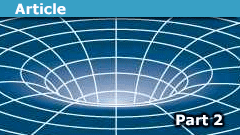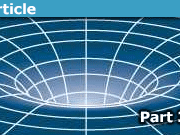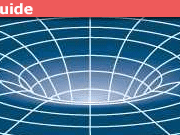The Schwarzschild Metric: The Photon Sphere
A Short Proof of Birkoff’s Theorem derived the Schwarzschild metric in units of ##G = c = 1##:
\begin{equation} ds^2 = -\left(1 – \frac{2M}{r}\right)dt^2 + \left(1 – \frac{2M}{r}\right)^{-1}dr^2 + r^2d\theta^2 + r^2 \sin^2\theta d\phi^2 \label{metric} \end{equation}
and I used that metric in The Schwarzschild Metric: Part 1, GPS Satellites to show that Global Positioning System (GPS) clocks in orbit around Earth run faster than Earth-based clocks. We saw that without the appropriate general relativistic correction, GPS tracking would be off by over 11 km per day. In this Insight, I want to use a result from Part 1, GPS Satellites to discuss the “photon sphere,” i.e., the radial coordinate at which photons orbit ##M##.
In Part 1, GPS Satellites, I showed that proper time lapse ##\Delta\tau_o## for an observer in circular, geodetic orbit at ##r = r_o## about ##M## is:
\begin{equation} \Delta\tau_o = \sqrt{1 – \frac{3M}{r_o}}\, \Delta t \label{OrbitObsTime} \end{equation}
where ##\Delta t## is coordinate time lapse, i.e., proper time lapse for an observer far from, and at rest with respect to, ##M##. We notice immediately from this equation that ##\Delta\tau_o = 0## at ##r_o = 3M##. Proper time lapse equals zero on null worldlines, i.e., photon paths, by definition. Thus, we see that photons will orbit ##M## at ##r_o = 3M##, so this is called the “photon sphere.” That means an observer hovering at ##r_o = 3M## would see the bottoms of his feet when he looked up (chest and back aligned radially), since light emitted from the bottoms of his feet would orbit ##M## and return to his location from “above.” Essentially, he would see an inverted ring image of himself at the photon sphere [1].
In order to hover there, the observer would have to accelerate per general relativity (GR), i.e., an observer in free fall (geodetic motion) is not accelerating per GR. This differs from Newtonian physics where the hovering observer’s acceleration would be zero while the free fall observer would be accelerating. To find the GR acceleration ##\overrightarrow{a}## of this hovering observer using the Schwarzschild metric Eq(\ref{metric}), we need to compute the deviation from geodetic motion. That is given by:
\begin{equation} \overrightarrow{a} = \nabla_{\overrightarrow{v}}\overrightarrow{v} \label{accelEq} \end{equation}
where ##\overrightarrow{v}## is the 4-velocity of the hovering observer and ##\nabla## is the covariant derivative. The RHS of Eq(\ref{accelEq}) is:
\begin{equation} \left(\frac{d^2 x^i}{d\tau^2} + \Gamma^i_{jk} \frac{dx^j}{d\tau}\frac{dx^k}{d\tau}\right) \frac{\partial}{\partial x^i} \label{GdscEq} \end{equation}
which we recognize from Part 1, GPS Satellites as the geodesic equation when set equal to zero. Again, the deviation from geodetic motion is acceleration in GR. The 4-velocity is defined to be:
\begin{equation} \overrightarrow{v} = \frac{d\overrightarrow{x}}{d\tau} \label{4velocity} \end{equation}
where ##\overrightarrow{x}## is the 4-position. For the hovering observer ##\overrightarrow{x} = (t, r_o, \theta, \phi)## so
\begin{equation} \overrightarrow{v} = (\frac{dt}{d\tau},0,0,0) = (v^0,v^1,v^2,v^3) \label{4velocity2} \end{equation}
According to our metric Eq(\ref{metric}) we have:
\begin{equation} d\tau = \sqrt{1 – \frac{2M}{r_o}} dt \label{HoverObsTime} \end{equation}
when ##dr = d\theta = d\phi = 0##, since ##ds^2 = -d\tau^2## along the worldline. Eq(\ref{4velocity2}) and Eq(\ref{HoverObsTime}) tell us:
\begin{equation} \overrightarrow{v} = \frac{1}{\sqrt{1 – \frac{2M}{r_o}}} \frac{\partial}{\partial t} \label{4velocity3} \end{equation}
Plugging this into Eq(\ref{accelEq}) we obtain:
\begin{equation} \overrightarrow{a} = v^i \nabla_{\frac{\partial}{\partial x^i}}\left(v^k \frac{\partial}{\partial x^k}\right) = \left(v^0\right)^2 \nabla_0 \frac{\partial}{\partial x^0} = \left(v^0\right)^2 \Gamma^j_{00}\frac{\partial}{\partial x^j} = \frac{1}{\left(1 – \frac{2M}{r_o}\right)}\Gamma^1_{00}\frac{\partial}{\partial r} \label{accelEq2} \end{equation}
since the only non-zero ##\Gamma^j_{00}## is ##\Gamma^1_{00} = \frac{M}{r_o^2}\left(1 – \frac{2M}{r_o}\right)##, as obtained in Part 1, GPS Satellites. This gives:
\begin{equation} \overrightarrow{a} = \frac{GM}{r_o^2}\frac{\partial}{\partial r} \label{accelEq3} \end{equation}
which looks very Newtonian except for the sign (I have restored ##G## for comparison). That is, per Newtonian physics an observer in free fall at ##r = r_o## would be accelerating at ##-\frac{GM}{r_o^2} \widehat{r}## (radially inward) while the hovering observer would have zero acceleration. In GR, it is the hovering observer who is accelerating radially outward since that is his deviation from geodetic (free fall) motion. The ##\frac{GM}{r_o^2}## piece in Eq(\ref{accelEq3}) looks very Newtonian, but that is deceptive since ##\frac{\partial}{\partial r}## is not a unit length vector like ##\widehat{r}## in the Newtonian acceleration. Instead,
\begin{equation} \frac{\partial}{\partial r} \cdotp \frac{\partial}{\partial r} = g_{rr} = \left(1 – \frac{2M}{r}\right)^{-1} \label{Grr} \end{equation}
so
\begin{equation} \frac{\partial}{\partial r} = \frac{1}{\sqrt{\left(1 – \frac{2M}{r}\right)}}\widehat{r} \label{rhat} \end{equation}
Putting Eq(\ref{rhat}) into Eq(\ref{accelEq3}) we have:
\begin{equation} \overrightarrow{a} = \frac{1}{\sqrt{\left(1 – \frac{2M}{r_o}\right)}}\frac{GM}{r_o^2}\widehat{r} \label{accelEq4} \end{equation}
as given in The Schwarzschild Geometry: Part 1. Notice that attempting to hover at ##r_o = 2M##, i.e., the event horizon of a black hole, requires infinite acceleration (infinite force). There is much more on black holes in The Schwarzschild Geometry: Part 1 and its companions.
The last thing I want to compute in this Insight is the speed of our geodetic orbiting observer as measured by our hovering observer. We have:
\begin{equation} v = \frac{r_o d\phi}{d\tau} \label{v} \end{equation}
where ##r_o d\phi## is the infinitesimal spatial distance (arc length) and ##d\tau## is the infinitesimal proper time, both as measured by the hovering observer. We found in Part 1, GPS Satellites, that:
\begin{equation} \frac{d\phi}{dt} = \sqrt{\frac{M}{r_o^3}} \label{GdscEq4} \end{equation}
Using this and Eq(\ref{HoverObsTime}) in Eq{\ref{v}) we obtain:
\begin{equation} v = \frac{r_o}{\sqrt{\left(1 – \frac{2M}{r_o}\right)}} \sqrt{\frac{M}{r_o^3}} \label{v2} \end{equation}
Notice that at ##r_o = 3M## Eq(\ref{v2}) gives ##v = 1## or restoring ##c##, ##v = c##, as must be the case since we’re on the photon sphere.
References
- Stuckey, W.M.: The Schwarzschild black hole as a gravitational mirror, American Journal of Physics 61(5), 448–456 (1993).
PhD in general relativity (1987), researching foundations of physics since 1994. Coauthor of “Beyond the Dynamical Universe” (Oxford UP, 2018).




The link behind is broken (it tries to take one to the edit page of the intended page)Fixed, thanks!
The link behind and I used that metric in The Schwarzschild Metric: Part 1, GPS Satellites is broken (it tries to take one to the edit page of the intended page)